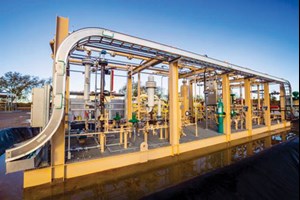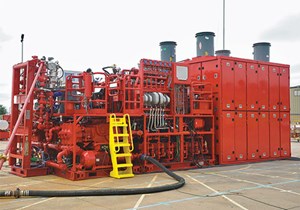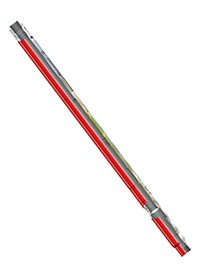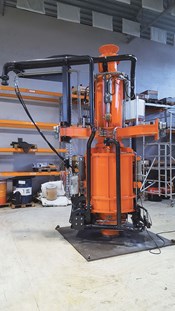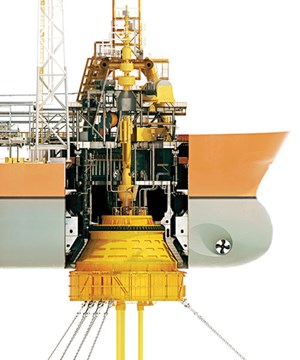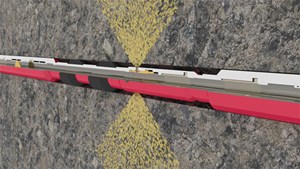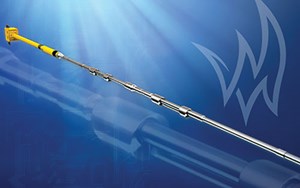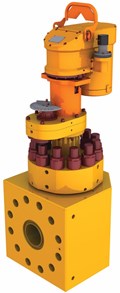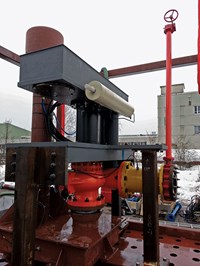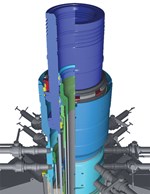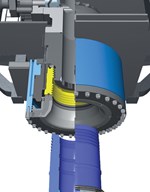OTC Spotlight on New Technology Awards: Inventions push performance through automation
The oil field continues to push performance by inventing new offshore drilling and subsea technologies, including automated technologies that improve operational safety and efficiency, as well as more reliable technologies that save time and capex. Companies, both large and small, have invested significant capital in creating tools and equipment that will allow the offshore oil and gas industry to continue to stay viable and competitive throughout the industry's cycles of downturns and upturns. The Offshore Technology Conference has awarded 17 companies its prestigious Spotlight on New Technology Award to recognize their efforts in these areas, including two Small Business Award winners—companies with less than 300 employees. ![]()
COMPACT MASS TRANSFER, INLINE SEPARATION TECHNOLOGY
Exxon Mobil has developed Compact Mass Transfer and Inline Separation Technology (cMIST), which dehydrates natural gas, using a patented absorption system inside pipes and replacing the need for conventional dehydration tower technology. This inline technology could be deployed at both land-based and offshore gas production operations. cMIST for dehydration is licensed to Sulzer for onshore and offshore applications.
The new technology efficiently removes water vapor present during the production of natural gas. Removing water vapor reduces corrosion and equipment interference, helping to ensure the safe and efficient transport of natural gas through supply infrastructure.
cMIST reduces the size, weight and cost of dehydration, resulting in reductions of surface footprint by 70% and the overall dehydration system’s weight by half, which has significant added benefits on offshore applications.
The technology relies on a proprietary droplet generator to break up conventional solvent into tiny droplets that become well-dispersed in the gas flow, thereby increasing the surface area for the absorption of water from the gas. This is followed by an inline separator that coalesces the water-rich glycol droplets and moves them to the outside wall of the pipe for effective separation from the dehydrated natural gas. The water-rich glycol is regenerated, using a conventional system, and is sent back to the droplet generator to be used again. The droplet generator uses the energy from the flowing gas to create droplets of the right size.
B-ANNULUS MONITORING SYSTEM
Annular pressure buildup is a challenge in producing wells and can in some cases, if not monitored and managed correctly, result in catastrophic well integrity events, such as inner casing collapse or outer casing burst. This is particularly challenging for subsea wells, and there are a number of industry regulations in development that will require monitoring of B-annulus pressure.
Statoil contracted Techni to develop the B-Annulus Monitoring System (BAMSE). BAMSE is a pressure and temperature sensor for installation in the B-annulus of oil and gas wells. The BAMSE system uses no active electronics in the inaccessible B-annulus and is designed for life-of-well reliability, according to the company.
The wireless and electronic-less pressure and temperature technologies developed for BAMSE are also being considered for a number of other applications.
OFFSHORE CEMENTING SYSTEM
The Halliburton HCS AdvantageOne offshore cementing system is designed specifically to address the complexities of deepwater and ultra-deepwater cementing, with the versatility for use in shallow water. This cementing system is optimized for an optional 20,000-psi manifold, to allow work in water depths that exceed the pressure limits of conventional equipment. This new 20,000-psi manifold increases well-control ability and can be used for pressure-testing deepwater subsea BOP stacks.
At the heart of the cementing system is the 25-bbl, three-compartment configurable RCM IIIr mixing system, and an integrated six-pump liquid additive system with dynamic inventory management. The liquid additive automated metering and pumping unit enables access to an array of additives required to tailor slurry systems for the demands of offshore wells, including ultra-deepwater wells.
The pumps are a completely new stainless steel design, providing instantaneous responsiveness for adjusting fluid flowrates to deliver advanced blend accuracy. Uniquely, the mixing system, liquid additive system, and the 80-ft3 steady-flow separator (dispenses dry cement) are all controlled by the same PLC system.
ELECTRIC TUBING-RETRIEVABLE SAFETY VALVE
The Halliburton EcoStar valve is the world’s first electric tubing-retrievable safety valve (e-TRSV). The EcoStar e-TRSV solves a 30-year industry challenge to remove hydraulic actuation and its limitations from the picture. The constraints of hydrostatics and fluid friction required to close a valve quickly, in the event of an emergency, and the distance from point of control to the subsea wellhead, are removed. This enables a fully electric completion system, with zero risk of exposing electronics to produced wellbore fluids.
This is made possible through a unique coupling mechanism between the actuator and the safety valve. The design and construction of the valve create a chamber for the downhole electronics and electric actuator outside of the wellbore, completely isolating them from well pressure and the detrimental effects of wellbore fluids. This makes it possible for operators to experience life-of-the-well reliability in electronics, a mandatory requirement for safety valve applications. The EcoStar e-TRSV provides direct positional feedback between the full-open and full-closed positions, and includes sensor communication back to the surface, which allows for analysis and diagnostic capabilities that are not available in any other safety valve today. Customers estimate that changing a subsea project from hydraulic to all-electric functionality can save as much as 40% on capex.
UNIVERSAL BOP TESTING TOOL
Samoco Oil Tools has designed One-Trip to greatly reduce the time and costs associated with mandatory BOP testing. The company collaborated with Shell Offshore to engineer, manufacture and test the new tool. Seven years ago, federally-mandated testing protocols required operators to test the integrity of their BOP equipment every 14 days.
These stricter protocols are essential, as testing detects potential problems that can endanger rig workers and the environment, according to the company. BOP testing is also very expensive for energy producers. Operators must interrupt rig operations for 36 to 72 hr, each time they perform a conventional BOP test.
Traditional methods perform three separately staged subtests of the BOP’s large ram, small ram, and sheering capabilities, which require testing tools to run multiple trips along the BOP stack. One-Trip’s proprietary design enables the testing of all three during a single trip down the hole.
One-Trip’s additional BOP testing capabilities include a low-torque, high-pressure seal design to ensure a resilient downhole seal. It can withstand harsh subsea conditions, endure a 25,000-psi test and sustain a load up to 1.2 million lb.
HIGH-POWER, PINLESS SUBSEA CONNECTOR
Small Business Winner.The Torden High Power Pinless Subsea Connector was developed in collaboration with NOV, to increase connection reliability between BOP and MRPs. This innovation further standardizes AUV & ROV connections, combining patented high-speed data transfer with highly-compact, resonant power transfer.
Underwater microwave-based connector solutions have proven to be disruptive, creating new possibilities for subsea operations. These advanced data transfer capabilities have been combined with high power in Torden, which delivers 1,000 watts of pin-less power transfer.
The pin-less connectors transfer data through seawater at much higher data rates than many other existing non-contact subsea communication methods, being based on high-speed, high-frequency microwave electronics versus low-frequency RF, inductive or acoustic technologies. Electronics and transducers are optimized for through-water transmissions.
MPD INTEGRATED SOLUTION
The Schlumberger MPD integrated solution is the industry’s first complete, all-OEM, reservoir-to-flare-stack deepwater MPD system. When MPD design, engineering, manufacturing, system integration, well engineering, and onsite well delivery services are delivered from one platform and from a single supplier, operators minimize rig footprint, while maximizing drilling efficiency and versatility.
Wells of all types can use MPD to enhance drilling efficiency and safety through rapid response to pressure changes. Schlumberger offers a complete OEM deepwater MPD system. A key component of this system is the integrated MPD riser joint, comprising the Cameron riser gas handling system and the M-I Swaco below-tension-ring rotating control device.
Integration of components ensures optimal performance and greater reliability, simplifies operations, and decreases personnel requirements and equipment footprint. It also provides the operator with a single point-of-contact and rapid response for all MPD-related matters.
CONTINUOUS DRILLING, CIRCULATION UNIT
The Continuous Drilling & Circulation Unit (CDU) from WeST Drilling Products AS, is a key component of the Continuous Motion Rig (CMR), offering the first continuous drilling operation, and also the first fully robotized circulation unit, according to the company.
The CDU enables the rig to drill and circulate continuously. This can make operations—like MPD, through continuous circulation, and casing running, through continuous running of the casing—more efficient. It also reduces safety risks by eliminating the use of personnel on the rig floor during drilling operations and, by removing pressure fluctuations, it can reduce the risk of spills and offshore pollution.
The tool can achieve 50% time reduction of drilling operations due to elimination of problems associated with differential sticking and pressure fluctuations, according to the company.
FPSO TURRET MOORING SYSTEM
The Turritella FPSO that Shell is using for its Stones project has a turret mooring system (TMS) that is the deepest mooring system of any floating production unit, and it is the first disconnectable TMS to support steel risers. The FPSO was implemented by SBM Offshore.
The converted Suezmax FPSO has a turret with a disconnectable buoy (buoyant turret mooring, or BTM), allowing it to weathervane in normal conditions and to safely disconnect from the FPSO upon the approach of a hurricane.
The FPSO uses new technology for the riser configuration and the design of this system features Steel Lazy-Wave Risers (SLWR). It is the first time that this type of riser is being used in a disconnectable production unit. As a consequence of this combination of water depth and steel risers, this buoy has the biggest displacement ever built, to date.
One feature developed for this project is the possibility to readjust each mooring line tension without any device installed on the FPSO. It pioneers the use of an in-line mooring connector (ILMC), which gives direct access to the mooring line for re-tension purposes. This feature allows more flexibility to adjust the tension of mooring lines, even during early installation phases.
RFID-ENABLED STIMULATION SYSTEM
The Weatherford AutoFrac system enables efficient stimulation in open-hole sections of extended-reach offshore wells, where traditional technologies often have failed to provide adequate reliability. The system allows remote operation of lower completion tools and provides several options for tool communication that do not rely on control lines or mechanical actuation: radio frequency identification (RFID) technology, frequency-modulated pressure pulses, ACTiFRAC pressure pulses, timers, or a combination of these methods.
By eliminating the need for interventions to achieve zonal isolation, the system reduces personnel and equipment on location, minimizes the number of trips in and out of hole, and enables optimal operational procedures—maximizing both hydrocarbon recovery and profitability.
This system has proven capable of functioning during a full screen-out. It also offers enhanced reliability by providing a surface-detectable positive confirmation upon completion of each stage. As an added option, the system can incorporate a memory logging tool that retrieves tool status information, temperature and pressure data directly from the tools, and provides the operator with information regarding tool status during operation.
REAL-TIME DRILLING INTELLIGENCE SERVICE
Schlumberger's OptiDrill real-time drilling intelligence service enables continuous real-time condition monitoring by integrating a comprehensive set of drilling dynamics and mechanical information. The service mitigates drilling risk and improves performance by providing actionable information to continuously identify hazardous drilling dynamics events and trends, and recommending safe operating parameters.
Using a downhole drilling mechanics and dynamics measurement sub, the service identifies the type and severity of BHA motions and calculates continuous borehole friction factors. With this information, the drilling team can reduce drillstring failures, extend the life of cutting structures and detect sticking pipe tendencies.
The service also provides information for the rig site team to identify the optimal drilling parameters to improve ROP. Simultaneously, the remote experts focus on the interpretation of longer-term trends, identifying performance limiters and anticipating risks. They also share opportunities for process improvement.
RISERLESS PLUG AND ABANDONMENT TOOL
The Wild Well DeepRange riserless plug and abandonment tool (P&A) uses a coiled tubing deployment procedure that requires, at most, a multi-service vessel to launch the system. The tool allows operators to perform BSEE-compliant P&A operations in water depths up to 10,000 ft, and on wells with a maximum shut-in pressure of 10,000 psi. The methodology can plug multi-annuli wells with specially designed perforating charges.
The tool's P&A process also allows the integrity of each annular plug to be verified, by enabling the client to test the plug from above and below. Additionally, Wild Well has developed a proprietary binary plug made of resin and cement, which can be used to increase the quality of each plug placed during abandonment.
Last year, the tool completed a nine-well P&A operation in ultra-deep water, in the Gulf of Mexico, months ahead of schedule. The job included isolation of the outer annulus in each of the wells by circulating more than 200 ft of cement in place and pressure-testing the plug.
With the ability to verify barriers without pulling the casing (leaving the casing in the ground), an additional environmental barrier is preserved that will remain long after the P&A operation is completed.
20K HPHT SUBSEA CHOKE
TechnipFMC’s 20K HPHT subsea choke is designed to reliably withstand the most severe conditions in HPHT oil and gas production environments, while eliminating the need for hydraulic control fluids.
Designed and qualified to meet or exceed API 17TRA, its plug-and-cage design combines proprietary HPHT sealing technologies and the company’s G2i electric actuator, providing more precise control of the choke position than conventional hydraulic actuation technology. The choke is qualified for 10,000-ft water depths (chokes for deeper water are under development), 20,000-psi maximum working pressure, and –20°F-to-350°F operating temperatures for oil, gas, and multi-phase production applications. HPHT systems with the 20K HPHT subsea choke will allow subsea operators to exploit deeper wells and allow such fields to be fully developed.
REAL-TIME FATIGUE MONITORING SYSTEM
Stress Engineering Services has developed a Riser Fatigue Monitoring System (RFMS) to provide field measurements of drilling riser stress and fatigue in real time.
The RFMS calculates drilling riser stress states, using measurements from accelerometers and angular rate sensors inside Subsea Vibration Data Logger (SVDL) modules, installed at strategic locations along the riser length. This method is preferred to resistive or fiber optic strain gauges due to the measurement quality and reliability concerns associated with installing such devices subsea. The SVDL units are connected via fiber optic subsea cabling to a central data acquisition system, located topside.
Data from each SVDL is displayed as it is acquired, and processed with a sophisticated online computer algorithm to synthesize stress estimates along the entire riser length, using a database of riser dynamic modes. The estimates are then processed chronologically via rainflow counting, recording fatigue damage accumulated during the deployment. The fatigue estimates are updated at 15-min. intervals, thereby providing actionable information to the drilling crew in real time. Additionally, the accumulated fatigue damage estimates may be tracked on a per-joint basis, as the riser joints are rotated among different well sites.
SUBSEA BOOSTING SYSTEM
Small Business Winner. The Omnirise miniBooster from Fuglesangs Subsea AS is a subsea boosting system that does not require external barrier fluid or topside variable speed drives.
The new boosting system consists of a hermetically sealed, liquid filled electric motor, coupled to a centrifugal pump, by means of a high performance subsea-qualified permanent magnetic coupling. The system includes unique seawater-lubricated hydrodynamic bearings. The system is modular, so that the drive unit (motor-coupling) design stays the same, even if the centrifugal pump characteristics need to change for each specific subsea project and fluid characteristics.
The system ensures that neither topside variable speed drives, traditional shaft seals nor external barrier fluid supply is necessary. As the system is hermetically sealed from both the surrounding seawater and from the pumped medium, there will be no controlled or uncontrolled leakage of barrier fluid system to the environment or to the process. It is confirmed that it is the only globally available subsea boosting system rated "GREEN" by the Norwegian Pollution Control Authority, as it is not releasing any harmful substances to the ocean.
The technology is a platform for a larger 1.5 MW boosting system with integrated hydrodynamic variable speed functionality, currently being qualified as part of a separate Demo2000 Project in Norway.
WELLHEAD SYSTEM
Dril-Quip's BigBore-IIe is a fully-qualified wellhead system, consisting of a DXe connection profile, integral high-capacity hanger lock-down, superior system fatigue, and high-capacity running tools. The system can provide cost-savings by reducing the number of trips into the well, eliminating drilling and production lock-down equipment, and allowing for reduction of casing strings. Wellhead component designs have been verified and validation tested to API 17D and API 6A PR2 Group 4 industry standards.
WELLHEAD CONNECTOR
Dril-Quip’s DXe wellhead connector, suitable for HPHT and severe cyclic load environments, has a highly-engineered locking profile and gasket design, providing high structural capacity and high fatigue resistance, resulting in longer service life. The technology of this critical connection is validated beyond API-16A-PR2 and API-TR7, with both structural and fatigue physical testing. ![]()

